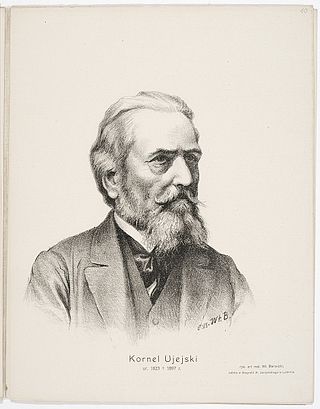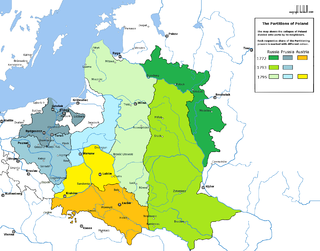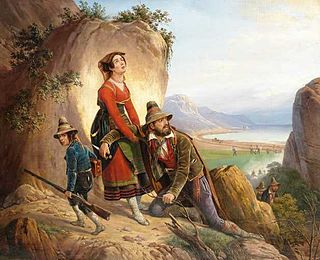
The Partitions of Poland were three partitions of the Polish–Lithuanian Commonwealth that took place toward the end of the 18th century and ended the existence of the state, resulting in the elimination of sovereign Poland and Lithuania for 123 years. The partitions were conducted by the Habsburg monarchy, the Kingdom of Prussia, and the Russian Empire, which divided up the Commonwealth lands among themselves progressively in the process of territorial seizures and annexations.
From 1795 to 1918, Poland was split between Prussia, the Habsburg monarchy, and Russia and had no independent existence. In 1795 the third and the last of the three 18th-century partitions of Poland ended the existence of the Polish–Lithuanian Commonwealth. Nevertheless, events both within and outside the Polish lands kept hopes for restoration of Polish independence alive throughout the 19th century. Poland's geopolitical location on the Northern European Lowlands became especially important in a period when its expansionist neighbors, the Kingdom of Prussia and Imperial Russia, involved themselves intensely in European rivalries and alliances as modern nation-states took form over the entire continent.

The January Uprising was an insurrection principally in Russia's Kingdom of Poland that was aimed at putting an end to Russian occupation of part of Poland and regaining independence. It began on 22 January 1863 and continued until the last insurgents were captured by the Russian forces in 1864.

Galicia is a historical and geographic region spanning what is now southeastern Poland and western Ukraine, long part of the Polish–Lithuanian Commonwealth. It covers much of the other historic regions of Red Ruthenia and Lesser Poland.

Ternopil Oblast, also referred to as Ternopilshchyna or Ternopillia, is an oblast (province) of Ukraine. Its administrative center is Ternopil, through which flows the Seret, a tributary of the Dniester. Population: 1,021,713.

The Kraków uprising of 1846 was an attempt, led by Polish insurgents such as Jan Tyssowski and Edward Dembowski, to incite a fight for national independence. The uprising was centered on the city of Kraków, the capital of a small state of Free City of Krakow. It was directed at the powers that partitioned Poland, in particular the nearby Austrian Empire. The uprising lasted about nine days and ended with an Austrian victory.

The Free, Independent, and Strictly Neutral City of Cracow with its Territory, more commonly known as the Free City of Cracow, and the Republic of Cracow, was a city republic created by the Congress of Vienna in 1815, which included the Polish city of Cracow and its surrounding areas.

The Kingdom of Galicia and Lodomeria, also known as Austrian Galicia or colloquially Austrian Poland, was a constituent possession of the Habsburg monarchy in the historical region of Galicia in Eastern Europe. The crownland was established in 1772. The lands were annexed from the Polish-Lithuanian Commonwealth as part of the First Partition of Poland. In 1804 it became a crownland of the newly proclaimed Austrian Empire. From 1867 it was a crownland within the Cisleithanian or Austrian half of the dual monarchy of Austria-Hungary. It maintained a degree of provincial autonomy. Its status remained unchanged until the dissolution of the monarchy in 1918.

Kornel Ujejski, also known as Cornelius Ujejski, was a Polish poet, patriot and political writer of the Austrian Empire and Austria-Hungary.

The Third Partition of Poland (1795) was the last in a series of the Partitions of Poland–Lithuania and the land of the Polish–Lithuanian Commonwealth among Prussia, the Habsburg monarchy, and the Russian Empire which effectively ended Polish–Lithuanian national sovereignty until 1918. The partition was the result of the Kościuszko Uprising and was followed by a number of Polish–Lithuanian uprisings during the period.
Polish Positivism was a social, literary and philosophical movement that became dominant in late-19th-century partitioned Poland following Romanticism in Poland and the suppression of the January 1863 Uprising against the Russian Empire. The Positivist period lasted until the turn of the 20th century and the advent of the modernist Young Poland movement.

There were many resistance movements in partitioned Poland between 1795 and 1918. Although some of the szlachta was reconciled to the end of the Polish–Lithuanian Commonwealth in 1795, the possibility of Polish independence was kept alive by events within and without Poland throughout the 19th century. Poland's location on the North European Plain became especially significant in a period when its neighbours, the Kingdom of Prussia and Russia were intensely involved in European rivalries and alliances and modern nation states took form over the entire continent.
The Union of Active Struggle, also translated as Union for Active Struggle and Union for Active Resistance, was a Polish secret military organization founded in June 1908 in Lwów by Józef Piłsudski, Marian Kukiel, Kazimierz Sosnkowski and Władysław Sikorski, all members of the Combat Organization of the Polish Socialist Party in the Kingdom of Poland.
After partitioning Poland at the end of the 18th century, the Kingdom of Prussia and later the German Empire imposed a number of Germanisation policies and measures in the newly gained territories, aimed at limiting the Polish ethnic presence and culture in these areas. This process continued through its various stages until the end of World War I, when most of the territories became part of the Second Polish Republic, which largely limited the capacity of further Germanisation efforts of the Weimar Republic until the occupation during World War II.

New Galicia or West Galicia was an administrative region of the Habsburg monarchy, constituted from the territory annexed in the course of the Third Partition of Poland in 1795.

The Austrian Partition comprises the former territories of the Polish–Lithuanian Commonwealth acquired by the Habsburg monarchy during the Partitions of Poland in the late 18th century. The three partitions were conducted jointly by the Russian Empire, the Kingdom of Prussia and Habsburg Austria, resulting in the complete elimination of the Polish Crown. Austria acquired Polish lands during the First Partition of 1772, and Third Partition of Poland in 1795. In the end, the Austrian sector encompassed the second-largest share of the Commonwealth's population after Russia; over 2.65 million people living on 128,900 km2 of land constituting the formerly south-central part of the Republic.

Austria–Poland relations are foreign relations between Austria and Poland. The two nations have a very long historical relationship dating back several centuries, which has been complicated throughout most of their history.

The Galician Peasant Uprising of 1846, also known as the Galician Rabacja, Galician Slaughter, or the Szela uprising, was a two-month uprising of impoverished Austrian Galician[a] peasants that led to the suppression of the szlachta uprising and the massacre of szlachta in Galicia, in the Austrian Partition zone, in early 1846. The uprising, which lasted from February to March, primarily affected the lands around the town of Tarnów.
With the arrival of the Hungarians into the heart of the Central European Plain around 899, Slavic tribes of Vistulans, White Croats, and Lendians found themselves under Hungarian rule. In 955 those areas north of the Carpathian Mountains constituted an autonomous part of the Duchy of Bohemia and remained so until around 972, when the first Polish territorial claims began to emerge. This area was mentioned in 981, when Vladimir the Great of Kievan Rus' claimed the area on his westward way. In the 11th century the area belonged to Poland, then reverted to Kievan Rus'. However, at the end of the 12th century the Hungarian claims to the principality turned up. Finally Casimir III of Poland annexed it in 1340–1349. Low Germans from Prussia and Middle Germany settled parts of northern and western Galicia from the 13th to 18th centuries, although the vast majority of the historic province remained independent from German and Austrian rule.

The Polish question was the issue, in international politics, of the existence of Poland as an independent state. Raised soon after the partitions of Poland in the late 18th century, it became a question current in European and American diplomacy throughout the 19th and parts of the 20th centuries. Historian Norman Davies notes that the Polish question is the primary lens through which most histories of Europe discuss the history of Poland, and was one of the most common topics of European politics for close to two centuries. The Polish question was a major topic at all major European peace conferences: at the Congress of Vienna in 1815, at the Versailles Conference in 1919, and at the Yalta Conference and the Potsdam Conference in 1945. As Piotr Wandycz writes, "What to the Poles was the Polish cause, to the outside world was the Polish question."













